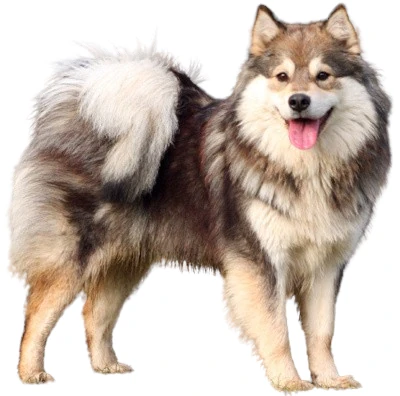
The Finnish Lapphund, also known as "Lapinkoira," is a breed of dog originating from the northern region of Finland. Traditionally used by the indigenous Sami people for the herding and guarding of reindeer, this dog is known for its robustness, intelligence, and friendly nature. Today, it is valued as a companion dog for its sociable nature and attachment to family.
The Finnish Lapphund is a medium-sized, well-proportioned and muscular dog with a solid bone structure. Its head is broad with a slightly tapered muzzle. The eyes are medium-sized, typically dark brown, and express great intelligence and gentleness. The ears are medium-sized, triangular, and stand erect. It has a bushy tail that often curls over its back, especially when in motion.
Males generally stand between 46 and 52 cm at the withers, while females measure between 41 and 47 cm. Their weight ranges from 15 to 24 kg, with males typically being heavier than females. Despite their medium size, these dogs have remarkable endurance, making them perfect companions for outdoor activities.
The Finnish Lapphund has a dense and thick coat, suited to the harsh climates of Lapland. It has a soft, dense undercoat that protects it from the cold, and a longer, slightly coarse outer coat. Coat colors can vary but commonly include black, brown, sable, and white or cream markings on the head, chest, or legs. Regular brushing is necessary to maintain the health and appearance of its coat, especially during shedding periods.
The Finnish Lapphund is known for its friendly, gentle, and sociable nature. It is calm and affectionate with family members while being alert and watchful around strangers. Its herding instincts make it naturally protective, but it is not aggressive. This dog enjoys human company and can be reserved if left alone for long periods. It is intelligent and learns quickly but can be somewhat stubborn, requiring patient and consistent training.
The Finnish Lapphund is generally a robust breed but may be prone to some common issues seen in northern breeds, such as hip dysplasia and certain eye conditions. A balanced diet, regular veterinary care, and adequate exercise are essential to ensure its health and well-being. This dog needs regular exercise to stay fit and enjoys long walks and outdoor activities, especially in cooler climates.

The Finnish Lapphund Puppy is a medium-sized, sturdy dog breed well-suited to cold climates. Originating from northern regions, it has a thick double coat that protects it from harsh weather and low temperatures. This puppy is naturally sociable, affectionate, and highly loyal to its family. Intelligent and responsive to training, the Finnish Lapphund is particularly skilled for both work and companionship. It requires plenty of exercise and enjoys outdoor activities, making it an excellent companion for active families.
The price of a Finnish Lapphund Puppy typically ranges from 1000 to 1800 euros, depending on the breeder and lineage. It is advisable to go through a certified breeder to ensure the puppy's health and well-being. Additional costs for vaccinations and spaying/neutering should also be considered when adopting.
The Finnish Lapphund, also known as Lapinkoira, is a breed originating from Finland, known for its intelligence, liveliness, and guarding instincts. Traditionally used for herding reindeer, this dog requires firm yet gentle training, adapted to its lively and protective temperament. Here are some tips for training this unique breed.
Start training your Finnish Lapphund from a young age. This breed is intelligent and responsive but can be stubborn due to its strong guarding instincts. Use positive reinforcement methods, such as treats and praise, to encourage desired behaviors and maintain its interest.
Socialize your Finnish Lapphund as early as possible. Expose it to different environments, people, and animals to help it develop a balanced and confident attitude. This breed is naturally wary of strangers, and early socialization will help it adapt more easily.
Due to its guarding instincts and energy, it is essential to provide it with varied physical and mental activities. Interactive games, recall exercises, and guarding activities are particularly suitable for channeling its energy and stimulating its intelligence.
Finally, be patient and consistent in your approach. The Finnish Lapphund needs a calm and confident leader to thrive. Proper training will make it a loyal, energetic, and incredibly skilled guarding companion.